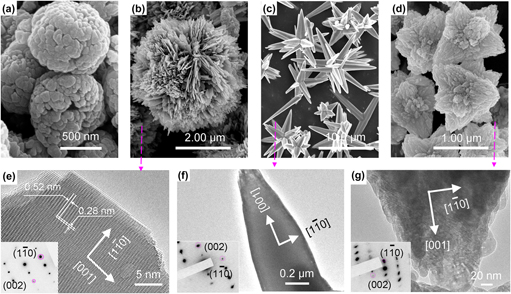Crossref Citations
This article has been cited by the following publications. This list is generated based on data provided by
Crossref.
Kundu, Subrata
and
Nithiyanantham, U.
2014.
DNA-Mediated Fast Synthesis of Shape-Selective ZnO Nanostructures and Their Potential Applications in Catalysis and Dye-Sensitized Solar Cells.
Industrial & Engineering Chemistry Research,
Vol. 53,
Issue. 35,
p.
13667.
Zhao, Biao
Shao, Gang
Fan, Bingbing
Xie, Yajun
Wang, Binbin
and
Zhang, Rui
2014.
Solvothermal synthesis and electromagnetic absorption properties of pyramidal Ni superstructures.
Journal of Materials Research,
Vol. 29,
Issue. 13,
p.
1431.
Liu, Jia
Cao, Wen-Qiang
Jin, Hai-Bo
Yuan, Jie
Zhang, De-Qing
and
Cao, Mao-Sheng
2015.
Enhanced permittivity and multi-region microwave absorption of nanoneedle-like ZnO in the X-band at elevated temperature.
Journal of Materials Chemistry C,
Vol. 3,
Issue. 18,
p.
4670.
Tong, Chaoli
Liu, Yun
Du, Fangfang
Tong, Guoxiu
and
Li, Liangchao
2015.
Enhanced microwave electromagnetic characteristics of porous ZnO/Ni/Zn NiyFe3−x−yO4 hybrid micro-hexahedra.
Materials Chemistry and Physics,
Vol. 163,
Issue. ,
p.
1.
Zhong, Bo
Tang, Xiaohui
Huang, Xiaoxiao
Xia, Long
Zhang, Xiaodong
Wen, Guangwu
and
Chen, Zi
2015.
Metal–semiconductor Zn/ZnO core–shell nanocables: facile and large-scale fabrication, growth mechanism, oxidation behavior, and microwave absorption performance.
CrystEngComm,
Vol. 17,
Issue. 14,
p.
2806.
Li, Yana
Wu, Tong
Jiang, Kedan
Tong, Guoxiu
Jin, Keying
Qian, Naxin
Zhao, Leihong
and
Lv, Tianxi
2016.
Mn2+ induced structure evolution and dual-frequency microwave absorption of MnxFe3−xO4 hollow/porous spherical chains made by a one-pot solvothermal approach.
Journal of Materials Chemistry C,
Vol. 4,
Issue. 29,
p.
7119.
Yang, Peipei
Liu, Ying
Zhao, Xiuchen
Cheng, Jingwei
and
Li, Hong
2016.
Electromagnetic wave absorption properties of FeCoNiCrAl0.8 high entropy alloy powders and its amorphous structure prepared by high-energy ball milling.
Journal of Materials Research,
Vol. 31,
Issue. 16,
p.
2398.
Zhao, Yanting
Liu, Lin
Han, Jianv
Wu, Wenhua
and
Tong, Guoxiu
2017.
Effective modulation of electromagnetic characteristics by composition and size in expanded graphite/Fe3O4 nanoring composites with high Snoek's limit.
Journal of Alloys and Compounds,
Vol. 728,
Issue. ,
p.
100.
Zhao, Yanting
Cui, Tingting
Wu, Tong
Jin, Chen
Qiao, Ru
Qian, Yao
and
Tong, Guoxiu
2017.
Polymorphous ZnO Nanostructures: Zn Polar Surface‐Guided Size and Shape Evolution Mechanism and Enhanced Photocatalytic Activity.
ChemCatChem,
Vol. 9,
Issue. 16,
p.
3180.
Li, Wangchang
Lv, Junjun
Zhou, Xiang
Zheng, Jingwu
Ying, Yao
Qiao, Liang
Yu, Jing
and
Che, Shenglei
2017.
Enhanced and broadband microwave absorption of flake-shaped Fe and FeNi composite with Ba ferrites.
Journal of Magnetism and Magnetic Materials,
Vol. 426,
Issue. ,
p.
504.
Zhao, Yanting
Liu, Lin
Cui, Tingting
Tong, Guoxiu
and
Wu, Wenhua
2017.
Enhanced photocatalytic properties of ZnO/reduced graphene oxide sheets (rGO) composites with controllable morphology and composition.
Applied Surface Science,
Vol. 412,
Issue. ,
p.
58.
He, Na
Liu, Minmin
Qi, Jiayi
Tong, Jiayue
Sao, Wen
Yang, Xiaochen
Shi, Lingxiu
and
Tong, Guoxiu
2019.
Plasmon resonance strategy to enhance permittivity and microwave absorbing performance of Cu/C core-shell nanowires.
Chemical Engineering Journal,
Vol. 378,
Issue. ,
p.
122160.
Yu, Kun
Hu, Shan
Yu, Wendi
and
Tan, Junqin
2019.
Dielectric and piezoelectric properties of 0.970(0.95(K0.485Na0.515)NbO3–0.05LiSbO3)–0.015CuO–0.015Al2O3/PVDF 0–3 composite reinforced with two kinds of ZnO powder.
Optical and Quantum Electronics,
Vol. 51,
Issue. 10,
Qi, Yujie
Qi, Lin
Liu, Liping
Dai, Bushi
Wei, Dongchao
Shi, Gui-Mei
and
Qi, Yang
2019.
Facile synthesis of lightweight carbonized hydrochars decorated with dispersed ZnO nanocrystals and enhanced microwave absorption properties.
Carbon,
Vol. 150,
Issue. ,
p.
259.
Ge, Chaoqun
Wang, Liuying
Liu, Gu
Wang, Tao
and
Chen, Haiqing
2019.
Synthesis of core–shell structured tetra-needle ZnO whisker and Fe composite with excellent electromagnetic properties.
Materials Letters,
Vol. 238,
Issue. ,
p.
126.
Zhang, Weidong
Zheng, Yuan
Zhang, Xue
Zhu, Qing
Tian, Lili
Wu, Hongjing
Yan, Hongxia
and
Qi, Shuhua
2019.
Structure-microwave absorption performance correlations of GNPs/ZnO nanocomposite absorber: Synthesis, characteration and mechanism investigation.
Ceramics International,
Vol. 45,
Issue. 10,
p.
13376.



